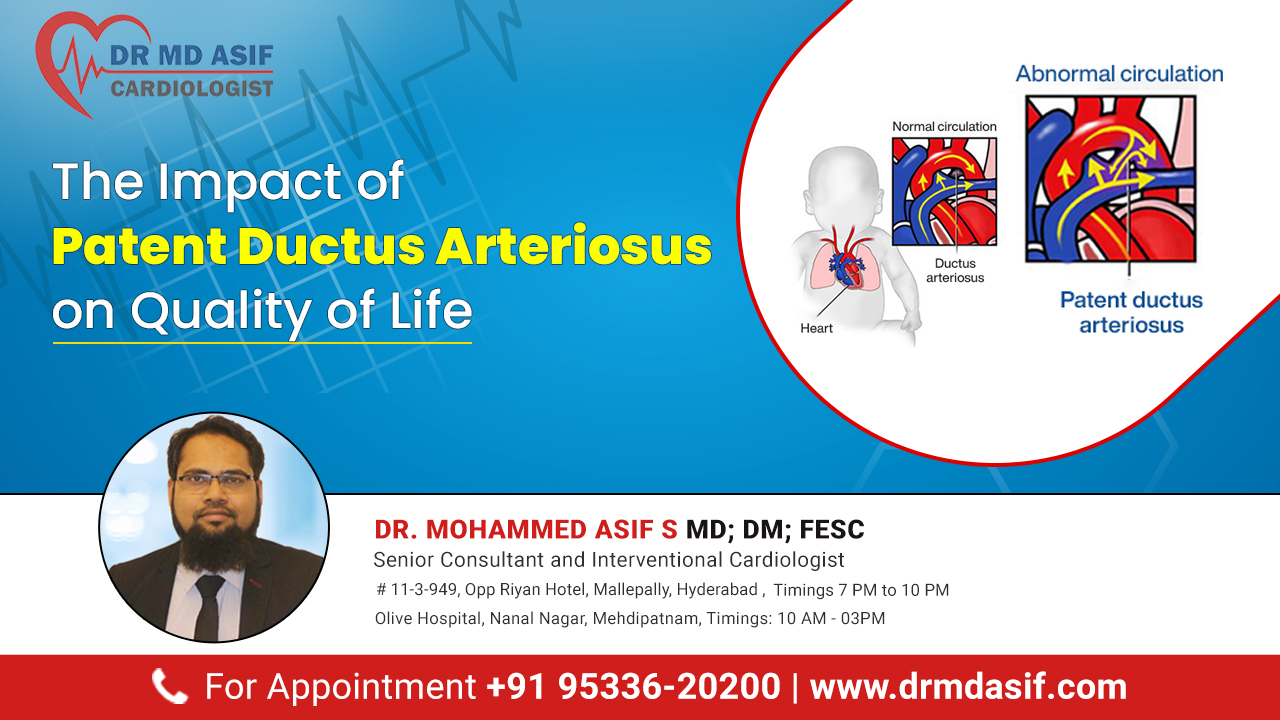Call us for any question
9533620200, 8179002888Meds Super Speciality Hospital
MallepallyTimings: 7 pm to 10 pm
mohammed4248asif@gmail.com

Blog s
The Impact of Patent Ductus Arteriosus on Quality of Life| Dr Asif

Updated at: 24 Aug 2023
What is Patent Ductus Arteriosus or PDA?
Patent Ductus Arteriosus, or PDA, is a congenital heart disorder. This condition occurs when the opening between the pulmonary artery and the aorta remains open longer than it should. Normally, this opening closes soon after birth. But in some cases, it persists, causing PDA. This condition leads to blood flow in the wrong direction, which burdens the heart and potentially leads to heart failure. PDA also poses risks for bacterial infection and pulmonary hypertension. Let us dive deeper into this to know about the impact of Patent Ductus Arteriosus on quality of life.
What are the causes of PDA closure?
Still, the researchers did not find the exact origins of patent ductus arteriosus or PDA. Though it is believed to have a hereditary component. PDA is commonly found in the following groups:
Premature infants
Babies with genetic conditions like Down syndrome.
Babies whose mothers had rubella during pregnancy.
Additionally, PDA is found to be twice as prevalent in women compared to boys.
What are the Indications for PDA Closure?
Closing a PDA is necessary when certain conditions arise. Such as:
Excessive volume overload in the left atrium and left ventricle
Increased risk of endocarditis
Elevated risk of pulmonary hypertension
Development of a PDA aneurysm
By exploring the causes and indications for PDA closure, the best cardiac surgeon in Hyderabad can better address and manage this condition.
Also read: Treatments of Ventricular septal defect
What are the main patent ductus arteriosus symptoms?
Symptoms vary based on the size of the PDA.
For those with a small PDA, a distinct heart murmur is often called a machine murmur. This may be the sole indicator of this patent ductus arteriosus or PDA.
However, individuals with a large PDA may experience additional signs, including:
Shortness of breath
Difficulty feeding and inadequate weight gain
Fatigue
Excessive sweating during meals
What are the top treatment options for PDA at the Best Heart Hospital in Hyderabad?
The Best Heart Hospital in Hyderabad offers a range of innovative treatments for PDA. The specific course of action will depend on the patients age and the severity of the condition.
Premature infants may see the PDA close naturally as they grow. But medication like indomethacin can also be utilised to facilitate closure. In some cases, surgical intervention may be necessary.
Full-term babies with small defects may simply need monitoring. These defects can sometimes close on their own. However, larger defects may require surgical closure.
The Best Heart Hospital in Hyderabad offers open-heart surgery and percutaneous catheterization procedures for surgical closures. The best cardiac surgeon in Hyderabad performs this procedure.
Who is the candidate for PDA device closure treatment?
Children may need this PDA device closure treatment if they meet the following criteria:
Age: Older than 6 months
Weight: At least 22 pounds
Defect size: Not too large
For adults, considerations include:
Lung pressure: Device closure may be an option if it is not irreversibly elevated.
Safety assessment: If lung pressure is high, careful measurement and evaluation of lung resistance will determine if the procedure is safe.
Also read: Different Types of ASD
What are the risks associated with the PDA device closure procedure?
Rupture of blood vessels or heart wall
Complications during device positioning
Leakage through the closure device
Other less common risks may include:
Bleeding and infection
Device displacement
Transient arrhythmia
Allergic reaction to the device
Clot formation
What are the essential diagnostic tests for PDA?
Echocardiography is one of the most essential tests to check heart issues and track their progression.
CXR, ECG, and Doppler study tests are also used to ensure a comprehensive diagnosis for PDA closure.
What happens before the PDA device closure procedure?
Before the PDA device closure, the childs medical history is reviewed, and a clinical evaluation is conducted. General evaluations are advised to test the childs fitness for the operation. The family is also counseled about the process.
What happens during the PDA device closure procedure?
The PDA device closure procedure typically takes 1 to 3 hours. A sheath is placed in the femoral vein, and another sheath is placed in the femoral artery. The device is then advanced to the point of the sheath from the descending aorta. Once in position, the sheath is retracted, and the device is opened inside the PDA. An angiogram is performed to ensure proper positioning, and if needed, the device can be repositioned or retrieved. Another angiogram may be done ten minutes later. If the device position is satisfactory, it is released.
What happens after the PDA device closure procedure?
After the PDA closure procedure, the patient must stay at the hospital for one day. So that the doctors can monitor their vitals. The next day, an X-ray and echo Doppler study will be done to confirm that the closure device has not moved. The patient is typically discharged after evaluation and kept on antibiotics. Antibiotic prophylaxis for subacute bacterial endocarditis is recommended for six months or until complete closure. The cardiologist may advise temporary restrictions on physical activity.
What are the factors that affect the PDA device closure price?
Multiple factors are there that impact the price of PDA device closure.
Such as:
Hospital fees, including operating and recovery room charges
Fees charged by physicians, such as cardiologists and anesthesiologists
Costs of medications and sterile dressings
Ongoing evaluation and diagnostic procedures
Price of necessary apparatus
Follow up care expenses
Conclusion
Patent Ductus Arteriosus (PDA) has a significant impact on the quality of life of those living with it. This condition can cause discomfort and cause difficulty with daily activities. It is essential to seek medical help when PDA symptoms arise to prevent more severe health complications. Such as heart disease. Individuals should consult an experienced interventional cardiologist like Dr Asif for proper diagnosis and treatment. He is one of the top Interventional cardiologists in Hyderabad. His wide range of expertise ensures that any heart condition experienced will be treated effectively & efficiently, leading to improved quality of life for his patients. Get in touch with Dr Asif to get exceptional care at affordable costs.
Comments

Be the first to Comment
Latest Post
-
⇨Heart Attack in the Gym: A Rising Concern
-
⇨Recognizing Early-Stage Blood Clot Symptoms in the Heart
-
⇨Obesity and Heart Disease: What is the Connection?
-
⇨Recognizing Early Signs of Prediabetes and Prevention Tips
-
⇨Impact of Chronic Rheumatic Heart Disease on Your Heart Health
-
⇨Connection Between Diabetes and Heart Disease: How It Affects Your Heart Health
-
⇨Why Regular Heart Check-ups Are Essential for Better Health
-
⇨10 ways to control high blood pressure without medication
-
⇨Know the Dos and Donts after heart bypass surgery
-
⇨Angioplasty vs CABG : All You Need to Know
-
⇨A Closer Look at Angiography Risks and Benefits
-
⇨What is the difference between angioplasty and angiogram?
-
⇨Connections Between Depression and Heart Disease: What You Need to Know
-
⇨Finding the Best Cardiologist in Hyderabad: Tips and Tricks
-
⇨How to Recognize the Signs of a Heart Attack or Heartburn
-
⇨Why Are Permanent Pacemakers Necessary, and what to expect during surgery?
-
⇨The Impact of Patent Ductus Arteriosus on Quality of Life| Dr Asif
-
⇨What Are the Causes, Risk Factors, and Treatments of Ventricular septal defect?
-
⇨Exploring the Pacemaker Surgery Cost in Hyderabad: What You Need to Know.
-
⇨Discovering the Different Types of ASD: What You Need to Know




Leave a reply